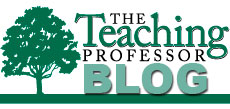One thing about student evaluations that troubles me is how they give students the impression that it’s the teacher who makes or breaks the course. A few instruments query students about their own efforts, but I’m not sure those kinds of questions make it clear that what happens in any course is the combined result of teacher and student actions. Early in my teaching career, I heard a wise colleague tell students, “It’s not my class. It’s not your class. It’s our class, and together we will make it a good or not-so-good learning experience.”
 Yes, faculty have more responsibility for what happens in the course than students do. Teachers can take all sorts of actions that positively impact course experiences—starting by demonstrating that we care about students. We can carefully prepare and organize course materials, design effective activities, treat all students fairly, offer clear explanations, and establish policies that promote learning. Although this list could go on and on, teachers can’t do everything it takes to create a constructive learning environment. If students decide not to speak in class, a participation policy that encourages interaction makes no difference. If students opt not to engage in the course activities the teacher has planned, those activities will not support learning. The teacher can lead, but if no one follows, the course doesn’t go anywhere.
Yes, faculty have more responsibility for what happens in the course than students do. Teachers can take all sorts of actions that positively impact course experiences—starting by demonstrating that we care about students. We can carefully prepare and organize course materials, design effective activities, treat all students fairly, offer clear explanations, and establish policies that promote learning. Although this list could go on and on, teachers can’t do everything it takes to create a constructive learning environment. If students decide not to speak in class, a participation policy that encourages interaction makes no difference. If students opt not to engage in the course activities the teacher has planned, those activities will not support learning. The teacher can lead, but if no one follows, the course doesn’t go anywhere.
Students can contribute to the success of a course in three different areas, starting with their individual efforts to learn. They can attend class or participate regularly online, do the reading or homework problems, pay attention, take notes, ask questions, study for exams, complete assignments, and take advantage of office hours and other resources when they need help.
Next, students can support the efforts that the teacher makes to help them learn. They can respond nonverbally by nodding, showing interest, and occasionally smiling. They can volunteer to answer questions as well as ask them. They can offer examples and share relevant experiences. They can participate in group activities and take leadership roles in getting the group started. They can provide the teacher with constructive feedback, suggesting ways the course could be improved and noting the teacher’s actions that help them learn.
Third, individual students can contribute to the learning experiences of others in the course. They can do that by avoiding disruptive behaviors like coming and going during class or surfing the web instead of taking notes and participating in discussions. They can help others by trying to clarify what’s confusing, respectfully responding to each other, learning the names of others in class, and chatting socially before class begins or via the online discussion board. What one or two students do makes a huge difference. If even a few students start contributing positively, everyone in the class feels the influence. Positive behaviors infuse the room with energy, keep the class flowing, and motivate other students to contribute. Unfortunately, the opposite is equally true.
I don’t think the ways in which we solicit instructional feedback from students makes them aware of their roles in the course and how they can contribute to a successful learning experience. “It was a boring course,” they write on the evaluation. Well, did you do anything to help make it interesting? “We had to work in groups, and it was a big waste of time.” Well, what did you do when the group was wasting time? “The homework problems weren’t at all like the ones we did in class.” Well, did you ask the instructor to explain how a homework problem was related to the ones solved in class?
So, how do we help students understand that what happens in a course is a shared responsibility? How do we encourage them to make contributions that are constructive? How about a midcourse evaluation titled something like, “How are we doing?” The students provide the teacher with some feedback—not so much on presentation skills but more on the climate for learning that exists within the course. In turn, the teacher provides the class (as a whole) with some feedback on their contributions to the well-being of the course. A follow-up discussion reveals the results, but it’s not about who’s at fault. Rather, it’s about how both the students and teacher could be doing better. It’s a forward-looking, action-oriented exchange.
On Faculty Focus Premium there is a feedback activity that highlights the roles played by teachers and students. It can be configured in a variety of different ways—three options are recommended here.
- Students can provide input on the conditions for learning created by the instructor.
- The instructor can provide input on how well students are functioning as a community of learners.
- The students can evaluate the course in terms of how it functions as a learning community.
Visit Creating a Climate for Learning: A Survey for Students and Teachers »






